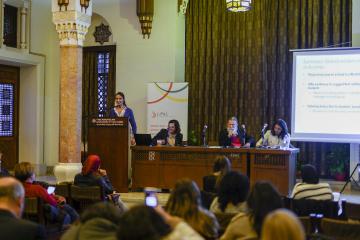
Improving female labor force participation in MENA

Despite substantial progress in the last few years, the economic gender gap in the Middle East and North Africa (MENA) region remains one of the largest in the world. Female labor force participation in MENA is the lowest globally, estimated at 20 percent in 2019.
Many factors contribute to this low participation rate in the region, including social norms, misinformation, employer discrimination, and poor job conditions. Evidence from recent randomized evaluations conducted in MENA help shed light on some reasons why participation rates are so low and what types of policies could help increase them. Overall, the evidence suggests that there are untapped opportunities to reduce gender employment gaps through policies that increase knowledge and improve work conditions and safety.
Social norms and misinformation
Social norms may contribute to the challenges women face when seeking equal economic opportunities. In a randomized evaluation conducted in Saudi Arabia to measure the effects of perceptions of social norms on female labor force participation, researchers found that while 87 percent of men supported female labor force participation, 72 percent underestimated other men’s support for women working outside the home. In other words, men misperceived others’ opinions, and this led them to discourage their wives from seeking work outside the home.
When men received accurate information on other men’s opinions, they often changed their views on whether their wives should work outside the home, which led to a 36 percent increase in the proportion of men who signed their wives up for job matching services. After the intervention, wives of men who received this information were also more likely to have applied for a job outside their homes and more likely to have had an interview. This finding suggests that updating men with accurate information about others’ perceptions may help shift social norms and lead to changes in behavior.
Misinformation about salaries could also discourage women from trying to find a job. Preliminary results of a study on using job fairs to improve job matching in Egypt show that 26 percent of women underestimated the wage range offered at the fair, while only 12 percent of men did so. Women were also willing to accept lower wages than men. Giving women information about the wages offered at the job fair increased their attendance and their reported reservation wages. These findings indicate that misperceptions about salaries may exacerbate the gender wage gap, as some women tend to underestimate their value in the labor market.
Employer discrimination
Another factor that may contribute to low female labor force participation is employers’ preferences. In a study on Egypt’s labor market, half of employers reported that they prefer to hire men over women, when asked both directly and indirectly. Employers were also asked if they place more weight on socioeconomic background than skills when hiring. About a third of employers affirmed the statement when asked directly, whereas more than half of respondents agreed when asked indirectly.
These responses indicate that employers discriminate against women and individuals of lower socioeconomic backgrounds, but their gender-based discrimination is explicit while their class-based discrimination tends to be more discreet. This implies that additional policy efforts focused on limiting gender-based discrimination could make a difference in a large proportion of the labor market.
Poor job conditions
Finally, poor job conditions may also reduce women’s work. Studies suggest that long working hours, childcare, and issues related to geographic mobility and commuting, often act as structural barriers to women’s entrance into the labor market.
In a study that attempts to quantify how people value job attributes in Egypt, researchers found that men and women value certain job features differently. When considering a job opportunity, the availability of on-site daycare services, flexible working hours, and no weekend work were valued more by women. Women also valued shorter commute times and jobs that are closer to home. These results imply that policies that improve job conditions that are especially valuable for women can have a large impact on women’s participation in the labor force.
In addition to commute time, an experiment assessing the demand for mobility in Egypt indicates that safety during travel is a primary concern for women. Researchers found that many women perceive public transport to be unsafe, and when they were offered discounts on Uber rides, women were more likely to substitute away from using buses, leading to a significant increase in their experienced levels of safety as well as increases in their overall mobility. These results suggest that making safe modes of transportation more accessible for women may enhance their mobility, limit their commute-related concerns, and eventually improve their labor force participation.
Open questions around increasing female labor for participation in MENA
Emerging evidence from randomized evaluations in Egypt suggests that a range of programs to support women finding and getting to work, and interventions to update men’s perceptions of women’s work can increase women’s labor force participation. In other words, while women continue to work outside the home at some of the lowest rates worldwide, we should not interpret this as the permanent state of the labor market in MENA.
An overarching question that remains is: how can women’s human capital be further utilized to contribute to the economic development of countries in MENA? Further research is needed to understand how to reduce barriers to female labor force participation, including factors that prevent women from seeking work outside the home or cause them to drop out of the labor market. Such factors include inadequate maternity leave and childcare, gender pay gaps in existing firms, structural inequalities that affect access to credit, and ways the shocks of COVID-19 exacerbate existing inequalities.
J-PAL MENA is actively working towards understanding barriers that restrict female labor force participation, and we are open to collaborating with policymakers in government and NGOs who are interested in designing and evaluating innovative new ways of improving women’s access to and participation in the region’s labor markets. Reach out to Norhan Muhab, Senior Research Associate at J-PAL MENA, and Nadeen ElAshmawy, Policy Associate at J-PAL MENA, to learn more about our work and find out how we can collaborate.
Related Content

Strengthening the Egyptian education system: A recap from the Global Evidence for Egypt spotlight seminar on education

Designing adaptive social assistance during COVID-19: A recap from the Evidence for Egypt Spotlight Webinar



